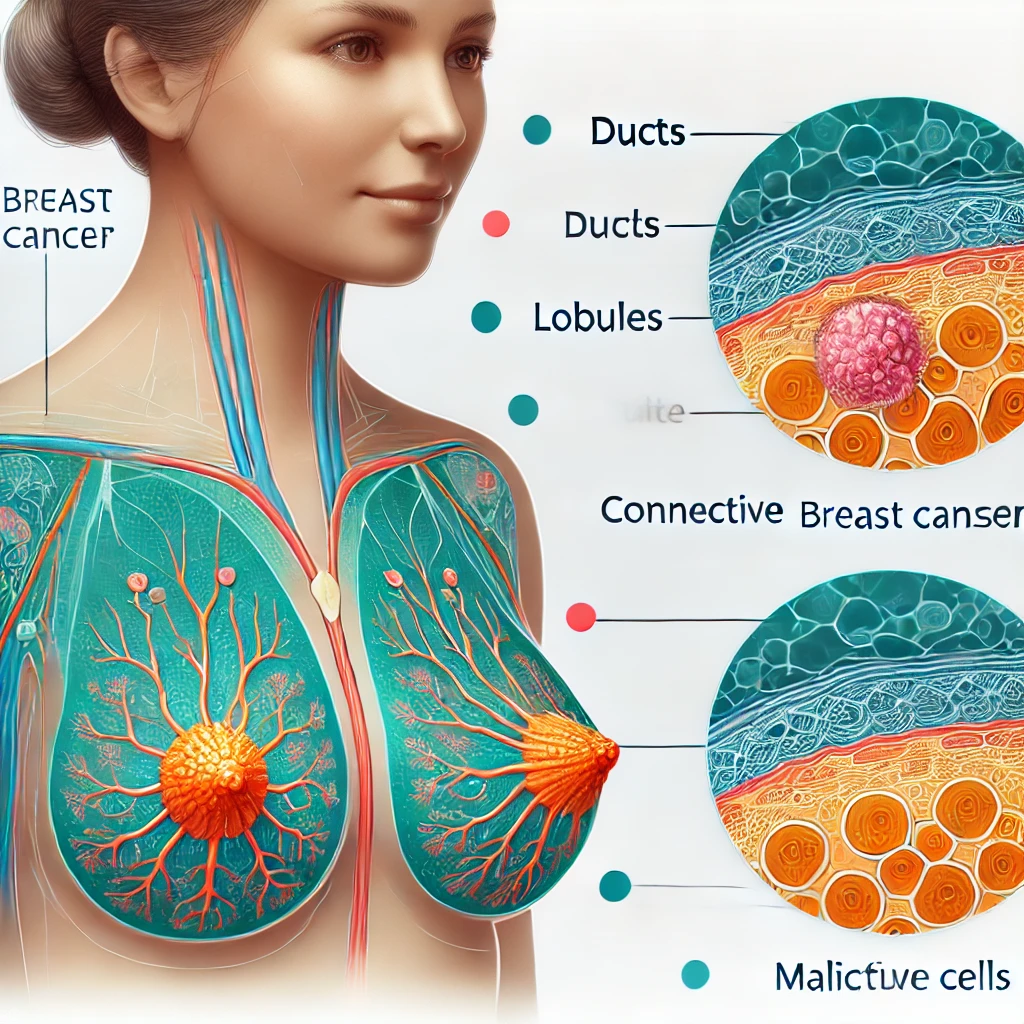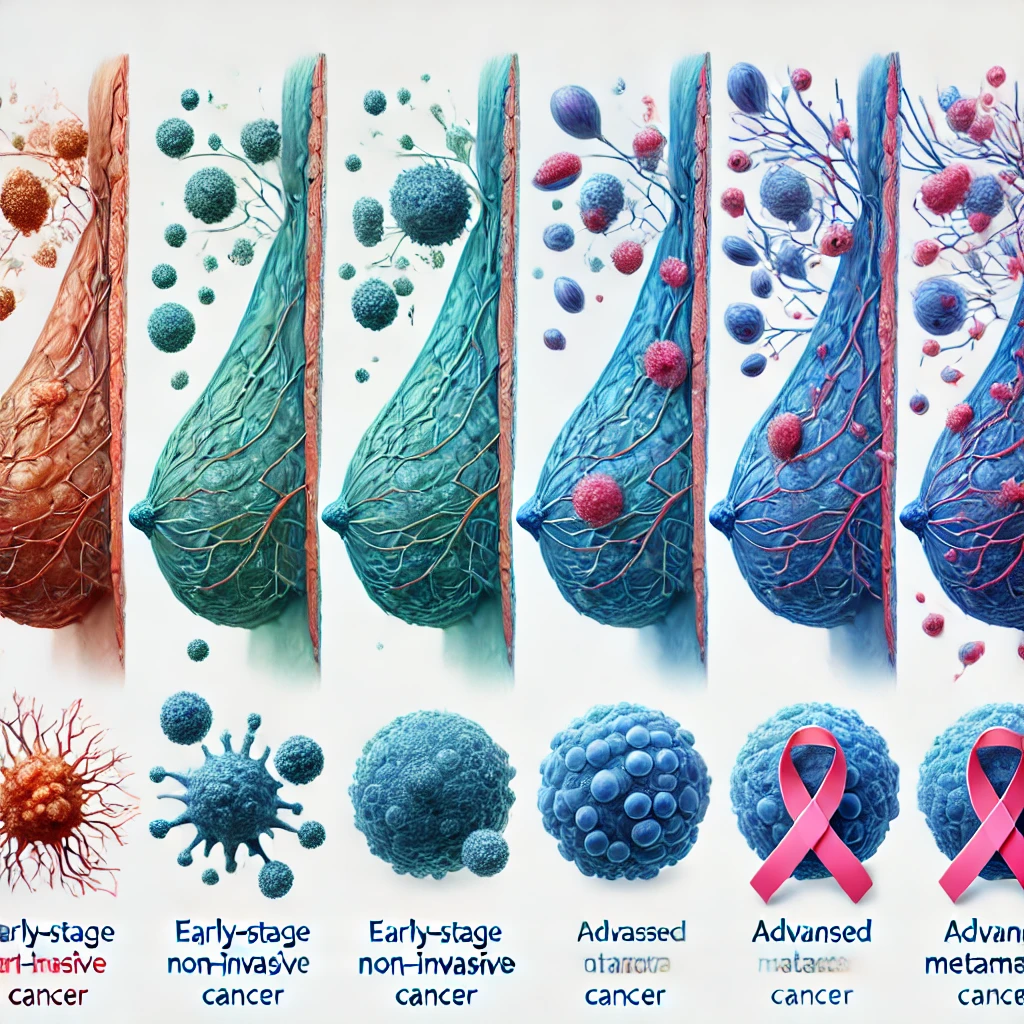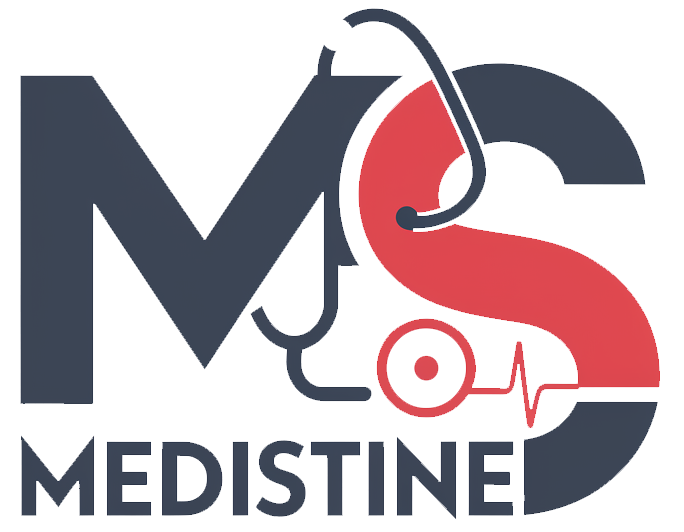Breast cancer is one of the most prevalent cancers globally, especially among women. It accounts for about 1 in 8 cancer diagnoses. While breast cancer predominantly affects women, men can also be affected, though the likelihood is much lower. This blog will explore this cancer in-depth, covering symptoms, risk factors, diagnosis, and treatment options.
What is Breast Cancer?
Breast cancer is a disease in which malignant (cancer) cells form in the tissues of the breast. These cells can form in different parts of the breast, including the ducts, lobules, and connective tissue. When these cells grow uncontrollably, they can invade nearby tissues or spread to other parts of the body, a process called metastasis.
Types
It can be classified into several types based on where it originates. The primary types include:
- Ductal Carcinoma In Situ (DCIS):
- The non-invasive cancer where abnormal cells are found in the lining of the breast duct but haven’t spread.
- Invasive Ductal Carcinoma (IDC):
- The most common type of breast cancer, IDC starts in the breast’s milk ducts and invades nearby tissues.
- Invasive Lobular Carcinoma (ILC):
- This cancer begins in the lobules (milk-producing glands) and can spread to surrounding tissues.
- Triple-Negative Breast Cancer:
- This type of breast cancer lacks three common receptors, making it more aggressive and harder to treat.
- HER2-Positive Breast Cancer:
- This cancer overexpresses a protein known as HER2 (human epidermal growth factor receptor 2), leading to rapid growth.
Symptoms of Breast Cancer

Early detection of breast cancer significantly improves the chances of successful treatment. The most common symptoms include:
- A Lump in the Breast or Underarm:
- A painless, firm mass in the breast or underarm is one of the most recognizable symptoms.
- Changes in Breast Shape or Size:
- The breast may swell, or its shape may change without any specific cause.
- Nipple Discharge:
- Unexplained discharge, especially if it’s bloody, from the nipple should be evaluated.
- Breast Skin Changes:
- Thickening, redness, or dimpling of the breast skin can indicate breast cancer.
- Nipple Retraction:
- The nipple may start to turn inward or change shape.
- Breast Pain:
- Though not always a sign, persistent pain in one area of the breast can be a symptom of breast cancer.
It is important to note that these symptoms can also be caused by other conditions like benign breast lumps or mastitis. Therefore, it’s vital to consult a healthcare provider for an accurate diagnosis.
Risk Factors of Breast Cancer
There are several factors that can increase the risk of developing breast cancer, and these can be classified into two broad categories: modifiable and non-modifiable risk factors.
- Non-Modifiable Risk Factors:
- Age: The risk of breast cancer increases as you age, with most diagnoses occurring after age 50.
- Gender: Women are at a significantly higher risk than men.
- Genetics: Mutations in genes such as BRCA1 and BRCA2 dramatically increase breast cancer risk.
- Family History: Having close relatives (especially a mother, sister, or daughter) with breast cancer raises the risk.
- Previous History: If you’ve had breast cancer before, the risk of recurrence is higher.
- Radiation Exposure: Exposure to radiation therapy, especially to the chest area during youth, can increase the risk.
- Modifiable Risk Factors:
- Hormone Replacement Therapy (HRT): Postmenopausal women who use HRT, especially combined estrogen-progesterone therapies, are at increased risk.
- Alcohol Consumption: Alcohol consumption is linked with increased risk of breast cancer.
- Obesity: Being overweight, particularly after menopause, can raise estrogen levels, increasing the risk.
- Lack of Physical Activity: An inactive lifestyle can contribute to weight gain and increased breast cancer risk.
- Reproductive History: Women who begin menstruation early (before age 12) or have late menopause (after age 55) have a higher risk of breast cancer due to prolonged exposure to hormones.
Prevention and Risk Reduction
While you can’t control many risk factors, there are steps you can take to reduce the risk:
- Maintain a Healthy Weight: Obesity after menopause significantly increases breast cancer risk.
- Exercise Regularly: Aim for at least 30 minutes of physical activity most days of the week.
- Limit Alcohol Consumption: Reducing alcohol intake can help decrease the risk of breast cancer.
- Breastfeeding: Some studies suggest that breastfeeding lowers the risk of breast cancer, especially if continued for a year or more.
- Avoid HRT: If possible, avoid hormone replacement therapy for menopause or use it only for short periods under medical advice.
Diagnosis
Early detection is crucial in the fight against breast cancer. The most common screening tools and diagnostic methods include:
- Mammogram:
- An X-ray of the breast used for screening and early detection of breast cancer. A Mammogram is recommended annually for women aged 40 and above or earlier for those at high risk.
- Ultrasound:
- Used to examine breast tissue in more detail, particularly for women with dense breasts or those with an abnormal mammogram.
- Magnetic Resonance Imaging (MRI):
- MRI can be used in conjunction with mammograms for women at high risk of breast cancer.
- Biopsy:
- If an abnormality is detected, a biopsy is performed to remove a small piece of tissue for analysis to confirm whether cancer is present.
- Genetic Testing:
- Testing for BRCA1 and BRCA2 gene mutations may be advised for those with a strong family history of breast or ovarian cancer.
Stages

Breast cancer is staged based on how large the tumor is and how far it has spread.
- Stage 0: Cancer is non-invasive and remains in the milk ducts (DCIS).
- Stage I: The cancer is small and confined to the breast tissue.
- Stage II: The cancer has grown but remains within the breast or has spread to nearby lymph nodes.
- Stage III: Cancer has spread to more lymph nodes or the chest wall.
- Stage IV: Also known as metastatic breast cancer, it indicates that the cancer has spread to other parts of the body, such as the lungs, bones, or liver.
Treatment Options
The treatment for breast cancer depends on the stage, type, and individual patient factors. Treatment strategies generally involve a combination of the following:
- Surgery:
- The most common treatment, which includes lumpectomy (removing the tumor) or mastectomy (removing the entire breast).
- Radiation Therapy:
- Often used after surgery to kill any remaining cancer cells and reduce the risk of recurrence.
- Chemotherapy:
- Drugs are administered to kill cancer cells throughout the body. This is especially used when cancer has spread beyond the breast.
- Hormonal Therapy:
- For hormone receptor-positive cancers, medications are used to block hormones like estrogen, which fuel cancer growth.
- Targeted Therapy:
- HER2-positive cancers may be treated with drugs like trastuzumab (Herceptin), which specifically targets HER2 receptors.
- Immunotherapy:
- In some cases, drugs that enhance the immune system’s ability to fight cancer cells are used.
Living with Breast Cancer
A breast cancer diagnosis can be overwhelming, but there are ways to manage both the disease and its emotional toll:
- Support Systems:
- Building a network of support, whether through family, friends, or support groups, is crucial in navigating the emotional challenges of breast cancer.
- Mental Health:
- Anxiety, depression, and fear are common among breast cancer patients. Mental health support, including counseling, is important during this time.
- Rehabilitation Programs:
- Many breast cancer patients benefit from rehabilitation programs that help regain physical strength and mobility post-surgery.
- Diet and Exercise:
- A well-balanced diet and regular physical activity can improve recovery outcomes and overall well-being.
Breast Cancer Survivorship
With advancements in early detection and treatment, the survival rates for breast cancer have significantly improved. According to statistics, the 5-year survival rate for localized breast cancer is 99%. However, this rate decreases as the cancer spreads to distant parts of the body. Regular follow-ups and a healthy lifestyle are essential components of survivorship care.
Conclusion
Breast cancer is a complex and multifaceted disease, but with early detection and modern treatment options, many individuals survive and thrive after diagnosis. Staying informed about symptoms, risk factors, and preventive measures can help reduce the chances of developing breast cancer. Remember to consult with a healthcare professional for routine screenings and personalized advice.



